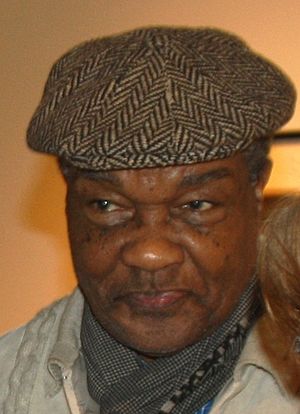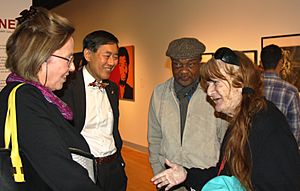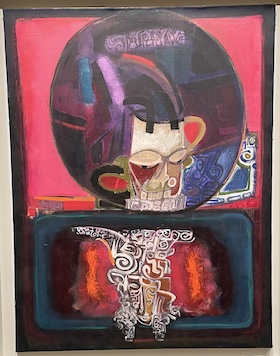David Driskell facts for kids
Quick facts for kids
David C. Driskell
|
|
|---|---|
 |
|
| Born | June 7, 1931 Eatonton, Georgia, U.S.
|
| Died | April 1, 2020 (aged 88) Washington, D.C., U.S.
|
| Nationality | American |
| Alma mater | Howard University (BA), Catholic University (MFA), Skowhegan School of Painting and Sculpture |
|
Notable work
|
Two Centuries of Black American Art |
| Awards | National Humanities Medal, 2000 |

David C. Driskell (born June 7, 1931 – died April 1, 2020) was an important American artist, scholar, and curator. A curator is someone who organizes art exhibitions. He was known for helping to make African-American art a recognized field of study. Many considered Driskell a top expert on African-American art during his lifetime. He was a respected professor of art at the University of Maryland, College Park.
Contents
Early Life and Education
David Clyde Driskell was born in 1931 in Eatonton, Georgia. His father, George Washington Driskell, was a Baptist minister. His mother, Mary Cloud Driskell, was a homemaker. David's grandfather, William Driskell, was born into slavery in 1862. He taught himself to be a minister.
When David was five, his family moved to western North Carolina. There, he went to schools that were separated by race. Art was already a part of his family life. His father painted religious pictures. His mother made quilts and baskets. His grandfather was a sculptor.
Driskell went to Howard University in Washington, D.C. He earned a bachelor's degree in art in 1955. He first studied painting and history. Then he met James A. Porter, a famous African-American art historian. Porter encouraged Driskell to study art history. Other important people who influenced him were James V. Herring and Mary Beattie Brady. Brady directed the William E. Harmon Foundation, which collected art by African Americans. Driskell worked closely with Brady early in his career.
In 1952, he married Thelma Grace DeLoatch. In 1953, he received a scholarship to attend the Skowhegan School of Painting and Sculpture.
His Career in Art
Teaching and Mentoring Young Artists
After teaching at Talladega College in Alabama, Driskell earned his Master of Fine Arts degree. He got this from The Catholic University of America in 1962.
He was an associate professor at Howard University from 1963 to 1964. In 1964, he had a special fellowship in the Netherlands.
In 1966, he joined Fisk University in Nashville. He became a professor and head of the art department. At Fisk, Driskell organized many shows featuring Black artists. These included Aaron Douglas and William T. Williams. He was a careful scholar. He cataloged African American artworks. This helped create a valuable archive for studying Black art.
Driskell taught at Bowdoin College in Maine in 1973. After ten years at Fisk, he moved to the University of Maryland, College Park, in 1976. He led the art department there from 1978 to 1983. In 1995, he was named a Distinguished University Professor of Art. Driskell retired from the University of Maryland in 1998.
In 2001, the David C. Driskell Center was named in his honor. This center studies the visual arts and culture of African Americans. It holds Driskell's important archive.
Driskell had a long connection with the Skowhegan School of Painting and Sculpture. He first attended as a student in 1953. Later, he returned as a faculty member many times. He also served on their boards.
He was known for guiding new art collectors. He also supported "younger, up-and-coming artists." A book about his life and work, David C. Driskell: Artist and Scholar, was published in 2006.
David Driskell passed away in Washington, D.C., on April 1, 2020. He died from problems related to COVID-19.
Organizing Art Exhibitions
During his long career, Driskell made huge contributions to the field of African American Art. He organized over 35 exhibitions of works by Black artists. These included famous artists like Jacob Lawrence and Romare Bearden.
In 1976, Driskell put together Two Centuries of Black American Art. This show was at the Los Angeles County Museum of Art. It was the most important exhibition of its kind at a major U.S. museum. It showed the deep and lasting contributions of Black artists since the country's early days. This landmark exhibition later traveled to other major museums. It featured more than 200 works by 63 artists. It also included works by unknown craftspeople. This show proved how important Black artists are to American visual culture.
Driskell's own art collection has traveled to museums across the country. It includes African tribal objects and modern art. His collection shows the history of the Black American experience. In 2000, about 100 works from his collection were shown at the High Museum of Art. The exhibition was called Narratives of African American Art and Identity: The David C. Driskell Collection.
Driskell also advised famous people like Oprah Winfrey on their art collections. He even chose artworks that appeared on The Cosby Show. He later wrote a book about the Cosby family's art collection. In 1996, Driskell advised the White House on buying a painting by Henry Ossawa Tanner. This painting, Sand Dunes at Sunset: Atlantic City (1885), was the first artwork by a Black artist in the White House collection.
His Own Artworks

Driskell created many types of art. He made paintings, drawings, collages, and prints. He often mixed these methods in his work. His art is hard to put into one category. He worked in both abstract and realistic styles. He used many materials like oil paint, acrylic, and ink. He painted on paper and canvas.
His art explored many subjects. These included portraits of jazz singers, African gods, city life, and landscapes. His work connects to the Black Arts Movement. It also shows his interest in many different art styles and time periods. His art reflects his openness to the world around him. This could be his neighborhood or nature.
A special exhibition of Driskell's work was planned for 2021. It was called Icons of Nature and History. It was organized by the High Museum of Art and the Portland Museum of Art. This show was to include over 60 artworks. These works came from museums, private collections, and Driskell’s own estate. They showed his studio work from the 1950s to the 2000s.
Selected Exhibitions
Driskell's art was shown in many places. Here are a few examples:
- 2019: David Driskell: Resonance, Paintings 1965-2002, DC Moore Gallery, New York, NY
- 2017: David Driskell: Renewal and Reform, Center for Maine Contemporary Art, Rockland, ME
- 2014: A Decade of David Driskell, The High Museum of Art, Atlanta, GA
- 2012: David Driskell, Creative Spirit: Five Decades, DC Moore Gallery, New York, NY
He also participated in important group shows:
- 2020: Tell Me Your Story, Kunsthal Kade, Amsterdam, NE
- 2020: Riffs and Relations: African American Artists and the European Modernist Tradition, The Phillips Collection, Washington D.C.
- 2019: Soul of a Nation: Art in the Age of Black Power, Tate Modern, London, UK
Honors, Awards, and Legacy
Driskell received many awards for his work. These include:
- Distinguished Alumni Award in Art from Howard University (1981)
- Distinguished Alumni Award in Art from The Catholic University of America (1996)
- President's Medal from University of Maryland (1997)
- Skowhegan School of Painting and Sculpture's Lifetime Legacy Award (2016)
In 2000, President Bill Clinton honored him with the Presidential Medal. This was part of the National Humanities Medal award. He also received nine honorary doctorates.
In 2005, the High Museum created the David C. Driskell Prize. This award celebrates people who have made great contributions to African American art. The prize is given every year to a scholar or artist in the U.S. Money from the award dinner also helps the museum buy art by African American artists.
Driskell became a member of the American Academy of Arts and Sciences in 2018.
The David C. Driskell Center at the University of Maryland, College Park, is named after him. It continues his legacy. In 2020, the Driskell Center showed a virtual exhibition. It included over 110 digitized items from his collection. These included his journal entries, writings, and photographs.
In September 2020, the National Gallery of Art honored Driskell. They recognized his contributions as a professor, artist, historian, collector, and curator.
In 2021, a documentary called Black Art paid tribute to Driskell. It featured his ideas on how Black artists have been left out of art history.
On May 4, 2021, the Hyattsville City Council voted to rename Magruder Park after David Driskell. This was done to remove the park's past connection to segregation.
See also
 In Spanish: David Driskell para niños
In Spanish: David Driskell para niños
- Sylvia Snowden (studied under Driskell)
- James A. Porter (Driskell's mentor at Howard University)


